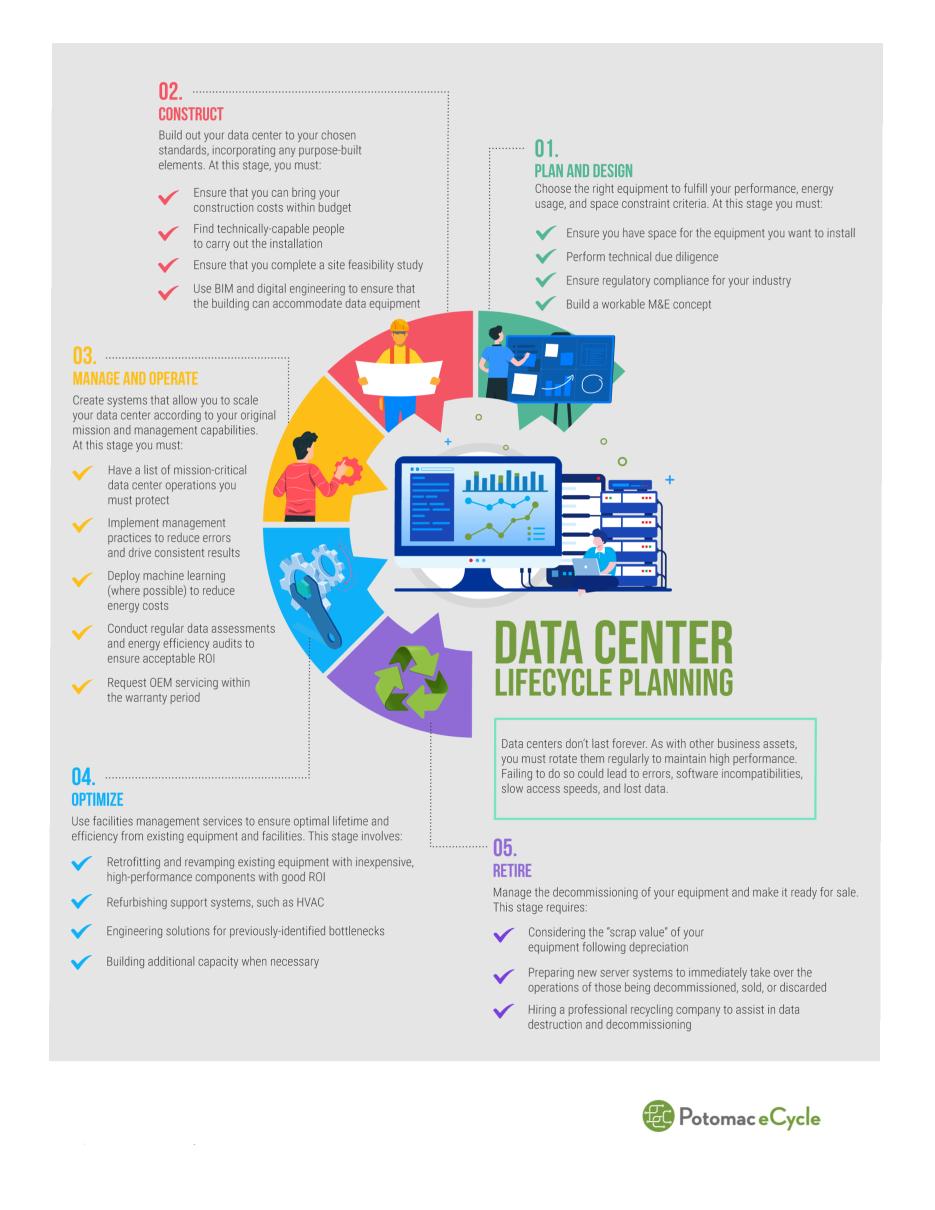Data Center Decommissioning
Data Center Decomissioning
Although it may sound illogical, allowing for eventual decommissioning should be part of the process of planning a data center at the outset.
The illustration below highlights the key steps in the data center lifecycle.

In this article we are concentrating on the final stage, the decommissioning of a data center.
Whether your company is migrating to the cloud, replacing single location services with colocation services or centralizing multiple data centers, the process of data center commissioning shouldn’t be taken lightly. The two most important things to plan out as fully as possible are: keeping sensitive data secure during the decommissioning and the safe disposal of discarded equipment.Example of a Data Center Decommissioning Project Plan
Although there is no “one size fits all” plan to decommission data centers, you can look at standardized templates and checklists to develop a plan that accommodates your own unique data center. The first thing IT managers need to do is take inventory of all hardware and associated materials.
Inventory lists should also detail attributes such as IP configuration/addresses, device models, memory capacity and vendor information. Minimally, any decommissioning plan should strive to avoid needless purchases, optimize the secure transfer of data and establish a proactive arrangement to dispose of equipment.
Compliance with state and federal decommissioning regulations is another critical aspect of your plan. Auditors may need to check your company’s decommissioning process flow chart to ensure you have complied with rigorous guidelines. Documentation of a data center decommission should contain the following information when faced with compliance audits:
- Exact dates and times when servers were disconnected from networks, software was removed and servers were erased for asset destruction and/or recovery
- Identification of all decommissioned servers
- Software licenses
- Cancellation data regarding software and maintenance contracts (if applicable)
- Descriptions of data back-up processes
- Descriptions of data wiping software used
- Flowchart delineating first and last steps towards physical destruction of data center equipment
This is only a bare-bones look at what to expect regarding audit compliance of data center decommissioning. For more information about developing an excellent data center decommissioning project plan, the U.S. General Services Administration (GSA) offers a comprehensive guide titled DCOI Guide for Data Center Migration, Consolidation, and Closure to help organizations decommission data centers.
Disposal of Data Center Equipment
How do you know data on decommissioned servers and hard drives are permanently destroyed? Making sure hard drives can no longer be accessed involves more than just smashing them or drilling a hole through the hard drive. In fact, you would be amazed at what sophisticated hackers can pull out of a hard drive that has supposedly been destroyed.
The best methods for ensuring data-containing hard drives and servers are permanently destroyed are degaussing, solid-state shredding and electronic shedding. Alternately, data wiping will completely erase data but also allows the equipment to be refurbished for future resale. Whether you chose to destroy data center components or refurbish them are decisions you should include in your data center decommissioning checklist.
By repositioning magnetic fields on hard drives, degaussing completely erases data so that it cannot be retrieved. Advantages to degaussing include:
- Permanently removes data
- Degaussed drives cannot operate in any system due to the inability of read heads to detect magnetic points for reference and tracking
- Can destroy nearly any type of device that uses a magnetic-based storage process
Removing data with degaussing is the most secure method of erasing data. However, the U.S. National Security Administration (NSA) recommends shredding and physically destroying media to fully optimize eradication of all data.
Contact Potomac eCycle for Assistance with Data Center Decommissioning
Potomac eCycle is committed to the responsible, ethical disposal of all types of electronic and computer equipment. Following disposal of your data center components, you will receive a certificate indicating these components and associated items have been disposed of or recycled responsibly according to Recycling Industry Operating Standard (RIOS) guidelines. Contact us today to learn more about our services as soon as you begin developing your data center decommissioning project plan.
